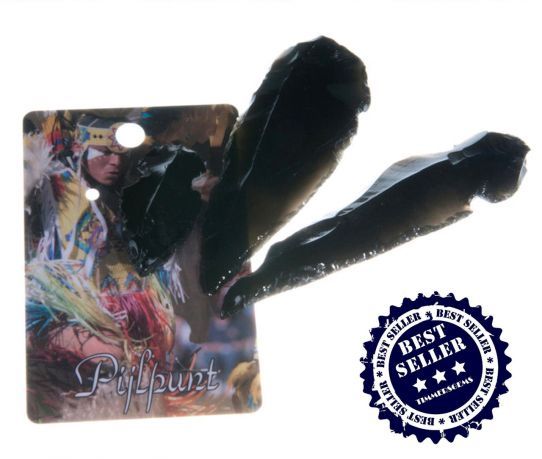We use cookies to make your experience better.
Original hand-beaten arrowheads small
- Buy 100 for €0.79 each and save 20%
An arrow is usually part of a bow and arrow being shot away, but there are weddings and special types of blowpipes and more varieties, see other arrows. Arrows are made in the course of the centuries in many forms and from different materials. For the construction were clamp connections, glue or thin binder material used, whether or not in combination. As the shooter had an interest in the performance equal of all his arrows, it required making arrows attention to detail. The arrow is put on the bow, consists of three main parts: point, shaft and feathering. Ancient arrows are almost exclusively found the points, because they were often made of durable material. Stable flight, the point are weighted to bring the center of gravity forward, and for use as a weapon, the point must be sharp and hard. For shape and size must always be a compromise between the aerodynamic properties of the point and the need to take lethal purpose or cause serious injury. In prehistoric times were arrowheads from flint or obsidian made. Both have the advantage of being readily form sharp edges: flint were repulsed sharp fragments with a sharp tool, obsidian has naturally sharp edges by its crystal lattice. Furthermore, also used bone splinters or thorns of plants, or was simply the arrow shaft cut sharply. In later times it was used bronze and iron; by forging and casting metals could be more accurately formed than stone, and were easier to make in large quantities. For greater effect, the arrow head has sometimes been dipped in arrow poison or provided with barbs.
Indians are the original inhabitants of America. Columbus, who thought in 1492 to be in India ended (it was his intention to close westbound Atlantic journey and to arrive in India) resident called indios - Indians. Because the name "Indian" assumes a Western point of view, there are several alternative names in vogue. In the United States introduced the US government and academics in the 60s of the 20th century the term Native American (Dutch: Native American) for the groups falling under the responsibility of the Bureau of Indian Affairs. An additional reason was the confusion with people of Indian origin, which in English are also called Indians. This new terminology, however, was not widely appreciated, because it was adopted without the participation of those involved, and because with this term Indians and the indigenous people of Alaska, Hawaii, Puerto Rico and the islands in the Pacific were lumped together. In a 2005 by the US Census Bureau survey showed that nearly 50% of the Indians prefer "American Indians" contracts, while slightly more than 37% prefer "Native American". Nowadays, both terms are used. It is noteworthy that the Bureau of Indian Affairs now uses the term American Indian rather than Native American. The term First Nations / Premières Nations is being used in Canada. In Latin America, the Indians are officially called indígenas (natives). In the scientific world, one also speaks of Amerindians or Amerindians. The Eskimos (sometimes called Inuit, all strikes that word not strictly on the Yupik in Alaska) are very often (in politics and in science) are not considered as Indians, albeit as "Native Americans". The emancipation which ethnic naming is concerned, both in Canada and the US are increasingly a thing of the indigenous communities themselves, which culturally and politically ever (itself) be aware. So give indigenous peoples are officially recognized by the US and Canadian governments and regard themselves as a mature political and cultural state, increasingly often no longer (as in the US) tribes (tribes), or (as in Canada) bands called wanting are, however Nations (nations or states). Also, the names that Europeans (or surrounding indigenous peoples) introduced in the past, more and more replaced by the names that people gave to themselves. Instead of Iroquois example, we speak often of Haudenosaunee. Other name changes include Lakota (Dakota / Nakota) Sioux, Mexicah for Aztecs, Mixtecs and Ñudzahui for Mapuche for Araucaniërs. "Indian" in Dutch not capitalized because it is not a nation but suggests several ethnic groups (like gypsies is the case). King William I then called his subjects in the Dutch East Indies in a number of his royal decrees "Indians." "Inlander" however became the common term. Upon the arrival of Columbus North America was divided into a number of culture regions. The best known are those of the far north (Arctic) and that of the prairies in the Midwest, the Great Plains. On the Plains, most people lived along the rivers and were farmers. In the east and southwest of North America also attended farmers. The main crops were corn, beans and pumpkins. These were originally from Mexico. Furthermore, cotton grown in the southwest and to the east include sunflowers. Tobacco was planted in nearly the entire current US and southern Canada. The stereotypical image of "the Indian" is based on the Plains peoples of the nineteenth century. This is not to say that Columbus (without horses!) No hunting was made on the bison and other animals. Especially in the northern part of the Great Plains are many so called "Buffalo Jumps". Here ere hunted bison in a ravine, where they fell to pieces. In Buffalo Jump Head-Smashed-In Alberta, Canada, a museum where you can see how this went into his work.












